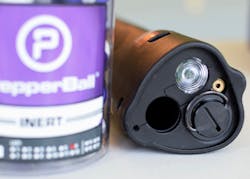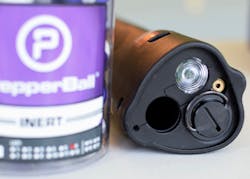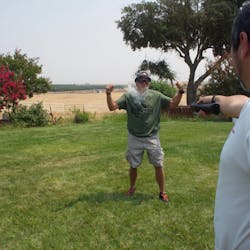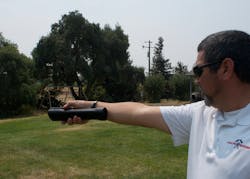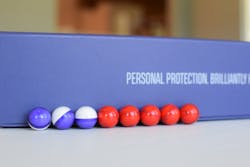Product Review: PepperBall LifeLite
When it comes to personal defense, or using less lethal tools to affect an arrest, the limitations of our tools define the range in which we can put them to work. An ECD device is limited by the spread of the darts and the length of the wire. A spray device is limited by distance. Distance equals time. If the less lethal tool can increase the standoff distance, it also might reduce the potential number of applications.
When testing the PepperBall LifeLite—a flashlight/PepperBall launcher combination, with a laser sight—I found the product effective at neutralizing an assailant at further distances than I would use OC spray, or even an ECD device. How do I know? I have several bruises from taking a hit. I can tell you personally that PepperBall delivers.
The LifeLite combines a flashlight and a PepperBall launcher in the same device. It uses standard 12 gram CO2 cartridges as the propellant with a five-round tubular magazine, allowing the launcher to rapid fire .68 caliber projectiles. The switch for the flashlight is completely independent of all of the switches, and it gives the user a tactile confirmation that they are using the light, not the device.
The trigger has two separate safeties—one is a removable pin and the other is a hood which slides over the trigger bar. This also gives visual and tactile confirmation and plenty of barriers to a negligent discharge. The removable pin is an optional feature I rarely used in my testing.
The trigger and safety mechanism makes it a good civilian tool. When the safety is slid back, it exposes the trigger. This is easily done with the thumb. When the safety, essentially a hood over the trigger, is slid back, the laser goes on.
First thoughts
I first had a look at the LifeLite and thought, “A flashlight connected to something that fires PepperBalls. This is a great way to make a traffic stop.” After playing with the product a little, I determined that this really is a viable application. It has enough of a built-in safety to prevent an accidental discharge, and it can be subtly put into action.
The laser is daylight bright, but it washed out in direct sunlight after 10 to 15 feet. During daytime though, point-and-shoot works.
The trigger is a large rod-shaped object that is pushed into the recess of the LifeLite body. The trigger is deliberately stiff, allowing the user to err on the side of caution.
When I first heard of this product, one of my greatest concerns was how the launcher would stay in a constant state of readiness if it relies on compressed gas cartridges. Once CO2 cartridges are punctured, their overall reliability becomes less predictable. PepperBall has addressed this in a manner I wasn’t expecting. The unit does not puncture the cartridge until it fires the first round. The cartridge is inserted into the LifeLite body and the cover is screwed down over the cartridge. The cover is actually a puncturing ram. The loaded cartridge is not punctured until the user trips the trigger for the first round. The ram slams the cartridge into the puncturing device and completely seals the chamber, which contains the compressed gas, at the same time.
I only got about four full magazines of practice rounds before the power started dropping off. I didn’t really count. The intent of this product is for any user to have a fresh, un-punctured CO2 cartridge in the launcher at any time.
Let’s get into the details
PepperBall rounds were designed to disperse their irritant in a zone. Although a direct hit is desirable, the effectiveness will remain in a 12-foot cloud under ideal conditions. According to PepperBall, just striking the ground in front of the target, within approximately 3 to 5 feet, is enough to deliver the irritant. Most PepperBall projectiles are designed for direct impact and area saturation. After testing both the projectiles and the powder, I found that it doesn’t take much to create an irritating cloud. This is definitely an efficient way to deliver less lethal irritants.
The PepperBalls did a good job breaking on impact, but when I wore padded clothing, it was harder to get them to break.
If you’re thinking that this product won’t work in the wind, this is incorrect. In fact, the first PepperBall can give the officer an idea of the wind conditions. The cloud is quite visible, in almost any light. The second round can be used to the officer’s advantage.
As soon as I was hit the first time, I realized that PepperBalls were going to work quicker than OC spray. Spray has to vaporize a bit in the air in order for it to be effective. Instead, this is an extremely fine powder that does not rely on vaporization. It’s already there. It didn’t take a second to be caught in my throat and begin stinging my lungs and face.Here’s the bonus round, and why this is great for protesters who block traffic: After I rinsed off my face, I thought I was done. Since it’s finely ground powder, it remained on my shirt until I got home to take a shower. I took the shirt off, again releasing the powder on my shirt back into the air.
Before I tested the product, I read that the LifeLite launcher can deliver its payload up to 60 feet away. It definitely will fire 60 feet. Launching PepperBalls in the vicinity of the target, and even on the target, is doable. At 60 feet, the laser is a little hard to hold on target, but it’s not difficult to get the payloads anywhere within 60 feet.
If there is an assailant approaching from 60 feet, the user can choose the standoff distance. The PepperBall LifeLite is definitely one of the most effective products out there, especially at moving targets.The flashlight part is a bright LED emitter, powered either by two CR123 cells, or an optional rechargeable battery. The emitter sits right alongside the CO2 cartridge and the barrel of the launcher. The light throws a suitably bright beam that concentrates most of the light in the center. The bright center itself is narrow enough to guide the launcher in a pinch.
Although the flashlight switch isn’t recessed, it has a rather strong spring that is adequate for preventing accidental presses. The switch sits opposite the launcher trigger. They both have enough tactile clues that confusing the two under stress is almost out of the question. I also found that I didn’t have much problem finding the switch as the cross-section of the launcher is triangular, but not equilateral. In the hand, it’s easy to orient.
I was surprised to see that PepperBall uses a battery tray to hold the batteries. This tray can come completely out of the flashlight body. It has a plastic door that covers the tray once fully assembled. I would have used a screw down cover for the batteries without a removable tray. This would also allow the manufacturer to place a dust and water seal around the battery compartment.
I discovered that my initial impression of the battery tray was correct. One of the inert training projectiles broke inside the launcher, either because of rough handling, or a depleted CO2 cartridge that didn’t allow it to initially exit the barrel correctly. When I fired another projectile, it blew the inert powder into the battery compartment, causing an intermittent connection on the flashlight and laser. With a sealed battery compartment, this could have been easily prevented.
I want to point out the fact that this is a worst-case scenario with this launcher, and it literally cleaned itself out. That is, sending the next projectile down the barrel cleaned out the barrel and launcher without getting any residual power near the user.
The launcher will send PepperBalls to the target regardless of whether the battery is working or not.
PepperBall has been recently awarded for their Variable Kinetic System to support soldiers with nonlethal force protection. The reason PepperBall products can be used in a force protection mode is their ability to deliver a live active irritant to a target with a usable standoff distance.
Packing a punch
The primary PepperBall projectile is a .68 caliber ball that resembles what paintball competitors use. The projectiles are completely different, however. The shell of the projectile is a hard plastic-like material, ultrasonically welded so that they remain waterproof and the payload remains inert until the capsule is broken. PepperBall color codes their projectiles so users can recognize what they are putting downrange immediately. Although there are several law enforcement rounds available for PepperBall delivery systems, the LifeLite Refill kit only comes with Live SD and Inert Practice projectiles. The Live SD rounds are exactly like the law enforcement Live-X projectiles, except they contain two percent PAVA (capsaicin), rather than five percent.The inert practice rounds contain a harmless, lavender-scented powder. They are purple.
Providing inert practice rounds at a reasonable cost is probably the best thing that PepperBall can do to demonstrate the effectiveness of the product. The first time I took my LifeLite out for a spin, I started to have second thoughts about being hit with one. They are designed for a muzzle velocity of about 285 to 325 ft./s, delivering 12 to 15 J of energy on the target. A Joule is a measure of kinetic energy transferred from a moving project out to the target. It is a combination of the speed and weight of the projectile, but, for the purposes of this type of ballistics, the surface area has to be another factor. An average BB gun will deliver 1 Joule. If your law enforcement training system uses Airsoft, you should know that recreational Airsoft “snipers” are asked to leave the field if their projectiles exceed about 5 J.
Although the PepperBalls themselves should be protected from significant shocks, they don’t need particular storage precautions or handling.
There is absolutely no doubt that the LifeLite is an outstanding law enforcement tool that can extend into civilian use. It is something that could probably be used in non-permissive environments.
Here are two law enforcement applications where the LifeLite would be very effective. First, delivering PepperBalls at a standoff distance is excellent for custodial settings. I’m not just thinking about having them on a skirmish line in a prison yard, I am literally thinking they would be a good idea for a cell extraction under certain circumstances.
Second, I have seen PepperBalls being delivered in a deliberate deployment, using designated officers for delivery. I think that every officer on a skirmish line should have such a launcher. They could be used for several purposes. First, they could augment the protective screen that designated officers provide. Second, when correctly equipped with either the Marking (delivers a high visibility color to individuals and objects) or LIVE (.5 percent PAVA), officers on the skirmish line can add additional precision to crowd control.
Finally, this is definitely an “officer’s spouse” product. It’s a bit large for the purse or backpack, but I’m thinking that every vehicle in my household should have one.
About the Author

Officer Lindsey Bertomen (ret.), Contributing Editor
Lindsey Bertomen is a retired police officer and retired military small arms trainer. He teaches criminal justice at Hartnell College in Salinas, California, where serves as a POST administrator and firearms instructor. He also teaches civilian firearms classes, enjoys fly fishing, martial arts, and mountain biking. His articles have appeared in print and online for over two decades.
